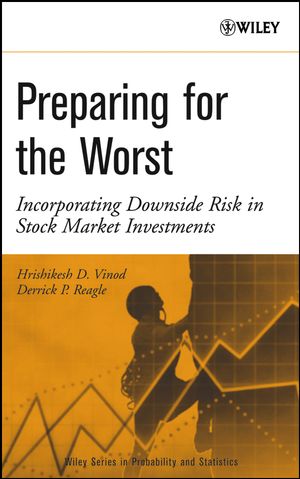Preparing for the Worst: Incorporating Downside Risk in Stock Market InvestmentsISBN: 978-0-471-23442-5
Hardcover
320 pages
October 2004
 |
||||||
List of Tables.
Preface.
1. Quantitative Measures of the Stock Market.
1.1. Pricing Future Cash Flows.
1.2. The Expected Return.
1.3. Volatility.
1.4. Modeling of Stock Price Diffusion.
1.5. Efficient Market Hypothesis.
Appendix: Simple Regression Analysis.
2. A Short Review of the Theory of Risk Measurement.
2.1. Quantiles and Value at Risk.
2.2. CAPM Beta, Sharpe, and Treynor Performance Measures.
2.3. When You Assume . . . .
2.4. Extensions of the CAPM.
Appendix: Estimating the Distribution from the Pearson Family of Distributions.
3. Hedging to Avoid Market Risk.
3.1. Derivative Securities: Futures, Options.
3.2. Valuing Derivative Securities.
3.3. Option Pricing Under Jump Diffusion.
3.4. Implied Volatility and the Greeks.
Appendix: Drift and Diffusion.
4. Monkey Wrench in the Works: When the Theory Fails.
4.1. Bubbles, Reversion, and Patterns.
4.2. Modeling Volatility or Variance Explicitly.
4.3. Testing for Normality.
4.4. Alternative Distributions.
5. Downside Risk.
5.1. VaR and Downside Risk.
5.2. Lower Partial Moments (Standard Deviation, Beta, Sharpe, and Treynor).
5.3. Implied Volatility and Other Measures of Downside Risk.
6. Portfolio Valuation and Utility Theory.
6.1. Utility Theory.
6.2. Nonexpected Utility Theory.
6.3. Incorporating Utility Theory into Risk Measurement and Stochastic Dominance.
6.4. Incorporating Utility Theory into Option Valuation.
6.5. Forecasting Returns Using Nonlinear Structures and Neural Networks.
7. Incorporating Downside Risk.
7.1. Investor Reactions.
7.2. Patterns of Downside Risk.
7.3. Downside Risk in Stock Valuations and Worldwide Investing.
7.4. Downside Risk Arising from Fraud, Corruption, and International Contagion.
8. Mathematical Techniques.
8.1. Matrix Algebra.
8.2. Matrix-Based Derivation of the Efficient Portfolio.
8.3. Principal Components Analysis, Factor Analysis, and Singular Value Decomposition.
8.4. Ito’s Lemma.
8.5. Creation of Risk-Free Nonrandom g(S, t) as a Hedge Portfolio.
8.6. Derivation of Black-Scholes Partial Differential Equation.
8.7. Risk-Neutral Case.
9. Computational Issues.
9.1. Sampling, Compounding, and Other Data Issues in Finance.
9.2. Numerical Procedures.
9.3. Simulations and Bootstrapping.
Appendix A: Regression Specification, Estimation, and Software Issues.
Appendix B: Maximum Likelihood Estimation Issues.
Appendix C: Maximum Entropy (ME) Bootstrap for State-Dependent Time Series of Returns.
10. What Does It All Mean?
Glossary of Greek Symbols.
Glossary of Notations.
Glossary of Abbreviations.
References.
Name Index.
Index.



